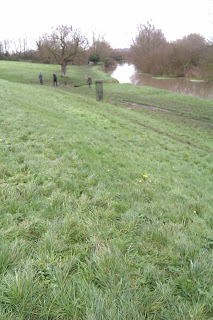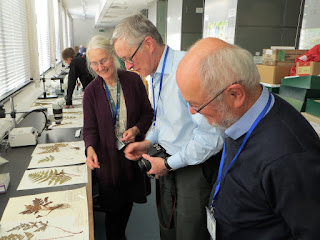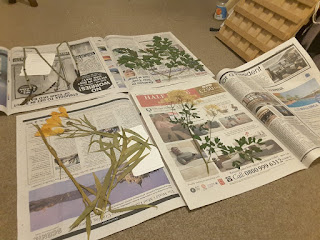 |
Jerry Clough talks about QGIS at the
BSBI Recorders' Conference 2018
Image: D. Alston |
One of the most popular talks at the recent BSBI Recorders' Conference was Jerry Clough's talk 'Introducing QGIS for botanical
recorders'. It was so popular that Jerry had to concede to requests for
an impromptu and informal drop-in session straight afterwards. We managed to
squeeze Jerry and several botanists in to the bar area as we already
had workshops running in all the classrooms!
With so much interest in QGIS, it seemed very fortuitous
when FSC's Rich Burkmar - Mr. QGIS himself! - contacted me to ask if BSBI
botanists would like to collaborate with FSC in promoting a consultation
they are running on the FSC Plugin for QGIS. I accepted on your behalf, so
over to Rich to tell us more:
"At the last NFBR conference at Preston Montford, Shropshire
- a conference aimed squarely at biological recorders - I was surprised how
many attendees, particularly those of younger generations, considered GIS to be
central to their biological recording skillset.
 |
Jerry's QGIS workshop: participants included
(from left): Jon Shanklin (BSBI Field Meetings
Secretary), Dave Barlow (joint BSBI County
Recorder, NE Yorks.) & Chris Metherell
(BSBI President)
Image: D. Alston |
"I'm really the last person that
should be surprised by this - I can't imagine pursuing my own interest in
biological recording without tools to spatially represent and analyse
biological records - but many biological recorders of my generation pursue
fulfilling interests in biological recording without going near GIS - that's
something they leave for other people.
"This generational shift must be influenced by a number of
things, for example it is likely that a higher proportion of younger biological
recorders want to pursue related careers where GIS skills are highly
sought-after. Another influence must be the increasing exposure of younger
generations to all sorts of digital technology, including GIS, from an early age
and the increasing accessibility of high-quality GIS tools.
 |
Screenshot of QGIS showing
the FSC plugin on the right |
"Over recent years,
QGIS has been a real game-changer in respect of making high-quality GIS more
accessible. QGIS started life over 15 years ago and has since become the
world's leading open-source desktop GIS. It started life as 'Quantum GIS' but
the 'Quantum' part has officially been dropped in favour of a simple enigmatic
'Q'! Like scientific names of plants, it doesn't really matter how you
pronounce QGIS, as long as you say it with confidence! (Personally I favour
'kew-jiss'.)
The FSC QGIS plugin
"Not only is QGIS freely available, but it supports a wide
range of operating systems including Windows, Mac OS X, Linux and Unix. There
is even an Android version under development. This means that choice of
hardware and operating system is unlikely to restrict access to QGIS. One of the best features of QGIS is its
extensibility: it is possible for any programmer with the requisite skills to
contribute a QGIS 'plugin' that extends the functionality of QGIS to carry out
particular tasks more efficiently. That's exactly what we did when we created
the 'FSC QGIS plugin' (also known as the 'TomBio plugin') for biological
recorders as part of the FSC's Tomorrow's Biodiversity project.
 |
The FSC team picking up the CIEEM
'Best Practice Award for Knowledge Sharing'
in 2017 from Baroness Young |
CIEEM Award
"The plugin plugs the gaps (pun intended) in QGIS when it
comes to dealing with biological records - particularly those geocoded with
Ordnance Survey grid references - as well as providing a number of other
utilities for UK biological recorders, e.g. easy access to NBN Atlas data from
within QGIS. The plugin has proved popular with over 31,000 downloads since its
release in November 2014. The last release for version 2 of QGIS (version 2.8.0
of the plugin) has had over 5,800 downloads and our recent new release for version
3 of QGIS (version 3.0.0 of the plugin) has been downloaded over 1,600 times.
The plugin was the winner of the 2017 CIEEM 'Best Practice Award for Knowledge
Sharing'.
What other QGIS gaps could the FSC QGIS plugin fill?
"When the FSC Tomorrow's Biodiversity project came to an end,
we were thrilled to be able to roll our support for the plugin forward into the
new FSC BioLinks project. This means that FSC plans to support the maintenance
and development of the plugin until, at least, the end of 2022. The release of
version 3.0.0 of the plugin was an early result of its adoption by the FSC
BioLinks project, requiring major reworking to accommodate the new architecture
of QGIS 3. The FSC QGIS Plugin was
amongst the first to be 'ported' to QGIS version 3. But support from BioLinks
will mean much more than simple maintenance of the current toolset.
 |
Jerry in full flow!
Image: O. Pescott |
"We want to hear your ideas about what functionality you
would like us to add to the plugin. For example one idea is to provide a direct
link to MapMate so that records can be mapped directly from a local MapMate
database without having to extract them first. Another is to be able to quickly
generated distribution maps divided into date classes. But what would you like to see? We're
interested in hearing your ideas - however simple or outlandish! We've created
a short online consultation where you can give us feedback on which of the
current tools in the plugin you find most useful; what works and what doesn't
and what new features, if any, you'd like to see.
"To have your say, please participate in the short online
consultation here. The consultation will be open until we carry out our next
round of development on the plugin (likely in second quarter 2019). The more responses we get, the more likely it is that the
next phase of development of the plugin will meet the needs of our biological
recording community, so please pass the link on to anyone that you believe might
be interested in expressing their ideas and opinions. Here's to the next five
years of the FSC QGIS plugin!"












